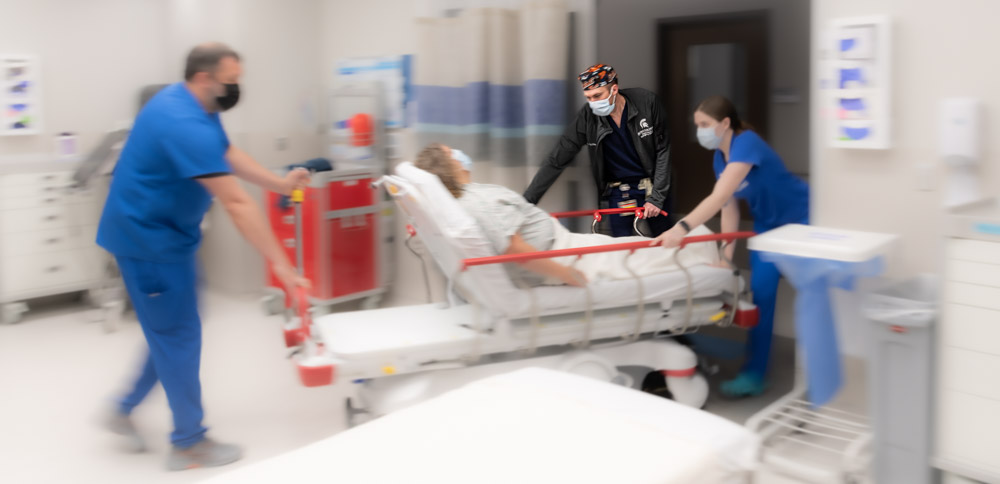Author: Sarah Barber

"We had to rethink the way we provide care. This means the experience you had a year ago may not look the same at your next visit."
The COVID-19 pandemic and the ongoing shortage of qualified workers across nearly every sector of the economy has brought enormous change to every industry and prompted organizations to fundamentally change how they provide services. Some of the more innovative changes can be found in health care, especially in how hospitals deliver emergency care. One major trend patients have noticed is that emergency care is being delivered in many locations and settings, and by different types of clinicians.
Some changes in emergency medicine were happening before the pandemic swept the world, like the presence of telemedicine, being seen by a physician assistant (PA) or nurse practitioner (NP), or receiving care in a nontraditional setting. However, the pandemic demanded that emergency care transform overnight to meet the medical emergencies of the people in the communities that health care professionals serve.
“We had to rethink the way we provide care,” said Tressa Gardner, DO, Medical Director of Emergency Medicine at McLaren Health Care. “This means the experience you had a year ago may not look the same at your next visit.”
This brings us to four common myths about the Emergency Department.
Myth 1: You are seen in the order you arrive or at an appointment time
“Care in an emergency room is prioritized to our patients who are the sickest and in need of treatment immediately,” said Dr. Gardner. “During the triage process we determine which patients need to be placed in a room first. This is not determined by when they checked in, when they arrived at the hospital, or how long they have been waiting."
When a patient arrives at the Emergency Department and checks in, they will be called up and evaluated (triaged) by a medical professional. Most of the time this process includes a nurse and NP or PA. The patient will explain their symptoms and reason for being at the ER. While collecting this information the nurse will get baseline health data (blood pressure, temperature, etc.).
Once the triage process is completed, patients will be placed in a room or in the waiting area, depending on the availability of beds and the seriousness of the injury or illness. The Emergency Department staff may order laboratory or radiology tests and treatment for those in the waiting room to expedite care.
Myth 2: Care begins in an ER exam room
Emergency departments have been forced to think outside of the box to continue to provide the best emergency care to everyone quickly, safely, and responsibly in the new world of employee shortages and high patient volumes.
“Some patients may receive treatment in our waiting room and if their symptoms improve, they may be discharged home without being in a room with a bed in the Emergency Department,” said Dr. Gardner.
This could include receiving some medications to help manage symptoms while the patient is waiting and ordering tests that are needed to help further diagnose the patient. These tests could include blood work, X-rays, CT scans, and more.
Once a patient has completed the triage process and received initial treatment and testing, the patient will wait for test results before staff can determine next steps. If it is determined that a patient needs to be admitted to the hospital, they may be moved to an Emergency Department room until a room in the hospital is available.
Myth 3: You will always be seen by a doctor
“We are reimagining the delivery of care,” said Dr. Gardner. “Now you will be seen by a nurse, and most of the time, a provider such as a nurse practitioner or physician assistant as soon as you walk through the door."
NPs and PAs are licensed clinicians who have completed additional education and practice beyond that of a registered nurse. These mid-level providers have been trained to order and interpret diagnostic and laboratory tests, diagnose disease, prescribe medications, and create treatment plans. This care is provided under the guidance of an emergency physician.
Myth 4: Your doctor will be in a white lab coat
Not only will the four walls you receive care in look different, but so might those providing care.
“Ever since COVID-19, most doctors no longer wear the traditional white lab coats. We are dressed in scrubs that are easily changed and cleaned and are easier when wearing disposable gowns in between patients,” said Dr. Gardner. “I think it’s also important for patients to know that while you may not see a doctor, we are always reviewing the charts for our emergency patients and providing direction and advice to nurses and providers.”
While care in the Emergency Department might look different, the goal is to expedite the process so patients can receive care, feel better, and get back home to continue their healing journey.
If your symptoms are non-emergent, it is best to visit an Urgent Care or schedule an appointment with your family doctor. There are primary care providers at McLaren that have same-day patient appointments available.
To schedule a telemedicine appointment with a McLaren provider, click here.
To find an urgent care affiliated with McLaren, click here.
To find a primary care provider accepting new patients click here.